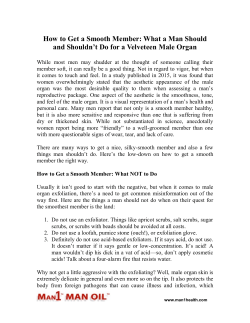
Male Organ Bumps from Seborrheic Keratosis Are Benign
Male Organ Bumps from Seborrheic Keratosis Are Benign “Uh-oh! What’s that?” This is a sentence no guy wants to utter while conducting a routine male organ health inspection—or even when just happening to glance at his equipment in the mirror—but it’s one that does come up from time to time. Often, the aberration that causes this exclamation is due to the discovery of new male organ bumps that had not previously blessed his member. There can be numerous reasons for the arrival of new male organ bumps, and fortunately many of them are benign – that is, harmless (even if in some cases unattractive). For instance, occasionally, bumps may be seborrheic keratosis, which don’t win prizes for their physical beauty, but which do not indicate a social disease or other male organ health problem. About seborrheic keratosis Okay, so they’re not dangerous – that’s good. But they mar an otherwise handsome manhood, so what should a guy know about them? Well, “seborrheic” means that it is related to the sebaceous glands. These are glands, found all over the body and secrete an oily or waxy matter. Some men are already familiar with sebaceous glands because they are the source of Fordyce spots – tiny little white or clear bumps that can appear on the skin of the manhood and the sacks. (They are completely harmless.) “Keratoses” refers to growths of keratin, which Wikipedia tells us is the “key structural material making up hair, nails, claws, hooves, and the outer layer of human skin.” So, seborrheic keratoses are basically growths made up of oily or waxy keratin. Appearance Although this article is concerned with seborrheic keratosis appearing as male organ bumps, they can appear anywhere on the body; in fact, they appear less commonly on the member than on the torso or face. They vary in color from light tan to brown to black. When they first appear, they tend to be small little bumps, but they gradually thicken and become elevated. Often www.man1health.com as they grow, they take on a warty look, causing some men to fear they have sensual organ warts – but they are not warts. They range in size from tiny to more than one inch, with most tending to be around a quarter- or half-inch. They are sometimes mistaken for signs of skin cancer, but again, they are actually benign. Seborrheic keratoses are more common in fairer-skinned people, and also more likely to occur when a person reaches middle age or older (although they can occur at younger ages). Removal Aside from an occasional itchiness, seborrheic keratoses don’t themselves cause much bother; however, they may get irritated when the member rubs against clothing or surfaces. In addition, because they do resemble sensual organ warts or cancerous growths, many men may wish to have them removed. There are several typical methods of removal, including: Cryosurgery, in which they are frozen off, much like common warts Curettage, in which special tools are used to scrape the very surface of the skin Ablation, in which a laser is used to vaporize the problem Electrocautery, in which an electrical current burns the growth away Often, a doctor may use a combination of these methods to remove the keratoses. Spotting new male organ bumps, whether caused by seborrheic keratoses or other causes, demonstrates that a man is practicing good male member care, and so he is hopefully already using a top-drawer male organ health creme (health professionals recommend Man 1 Man Oil, which is clinically proven mild and safe for skin) on a regular basis. Care should be taken in selecting a cream – one that contains both a high-end emollient (such as shea butter) and a natural hydrator (such as vitamin E). These ingredients combine to create a “moisture lock” that helps keep delicate manhood skin well hydrated and protected. Further protection is provided if the cream also contains alpha-lipoic acid, a powerful antioxidant that helps reduce the dangers of oxidative stress to member skin. www.man1health.com
© Copyright 2025













